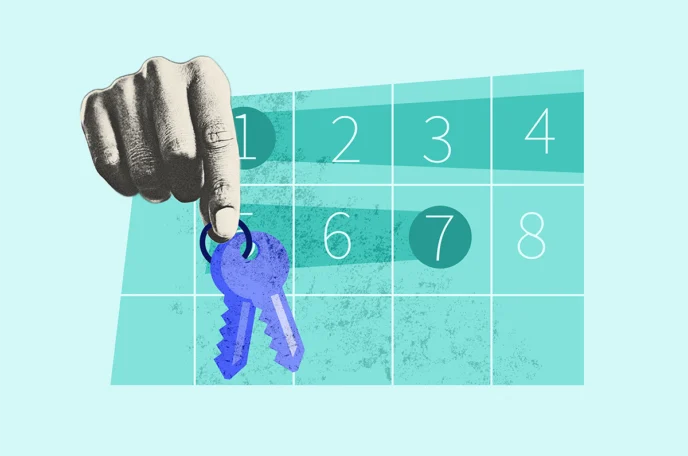
If you’re a tenant having trouble making rent due to economic hardship, you could apply for an eviction hardship extension. This extension, which may be called a hardship stay of eviction, gives tenants extra time to vacate the premises after an eviction, provided they meet certain requirements for economic hardship.
Understanding how to get an extension on eviction can help you obtain a positive outcome, as you can avoid immediate homelessness and potentially negotiate a mutually beneficial agreement with the landlord.
What Is an Eviction Hardship Extension?
An eviction hardship extension is a court-ordered stay of eviction that allows tenants to remain on the property after an eviction. You can file for a hardship stay of eviction after receiving a warrant for removal or warrant of assistance. It’s essential to adhere to the proper procedures and provide sufficient documentation to support your request, as a court will need to see adequate proof of your situation.
How Does It Help Tenants?
Eviction hardship extensions help tenants facing eviction due to financial difficulties. A hardship stay of eviction helps the tenant in the following ways:
- Gives the tenant time to catch up on unpaid rent
- Helps the tenant avoid immediate eviction
- Provides the tenant time to secure additional housing
- Ensures the tenant has stable housing for themselves and their family
- Lets the tenant become more financially stable without sudden displacement
Eligibility Criteria For an Eviction Hardship Extension
The fundamental basis of an eviction hardship extension is to assist tenants facing unexpected economic difficulties. Tenants must meet certain requirements to be eligible for this kind of assistance:
- Evidence of economic hardship: Such hardship may include job loss, serious illness, loss of income, disability, and other unforeseen circumstances. You must be able to prove hardship with documentation such as medical bills, medical records, affidavits, or unemployment benefit documents.
- Good faith effort: You must show that you made a good faith effort to communicate with the landlord about your hardship and resolve the issue. Proof may include emails, letters, and texts between you and the landlord. You can also document your verbal communication with a log indicating dates and times you had phone conversations or in-person discussions about the issue.
- Timeliness: You must abide by your jurisdiction’s deadline requirements. Upon receiving an eviction notice, review your state’s guidelines and time limits for responses and appeals. You may only have a few days to file for an eviction hardship extension, so time is of the essence.
- Lease compliance: Show that you’ve made every effort to comply with the lease to the best of your abilities. For instance, if you made partial rent payments, established an installment agreement, or made a good-faith effort to correct the issue, document these efforts as evidence.
- Written notice: Advise the landlord in writing that you’ve applied for an eviction hardship extension. Requirements and deadlines for serving notice differ depending on the jurisdiction, so review your state and local laws or consult a landlord-tenant attorney.
These are general requirements that typically apply to eviction hardship extensions. Guidelines for filing an extension request vary by state and locality, so verify the laws in your jurisdiction as soon as you receive communication from your landlord about lease violations.
Can I Negotiate a Repayment Plan with My Landlord?
You may be able to negotiate a repayment plan with your landlord. Contact them as soon as you know your rent will be late. If you have a good relationship and otherwise meet all the lease terms, they may agree to a repayment plan to keep you in the property.
Consider reassuring the landlord that your hardship is only temporary. For instance, if you lost your job, you may advise them that you have applications or interviews in progress.
How to Secure an Eviction Hardship Extension
Step 1 – Review Relevant Laws
Since laws regarding eviction hardship extensions differ by jurisdiction, your first step is to research the laws in your area. Pay special attention to filing and notification requirements and deadlines. Failure to meet legal filing requirements could create complications or harm your case.
Step 2 – Gather Documentation
To qualify for a hardship eviction, you must show the court that you suffered economic difficulties. Documentation that can help prove your financial hardship may include:
Proof of Income
This establishes your financial situation and ability to pay rent in the future. Examples include:
- Pay stubs
- Tax returns
- Government benefit statements
Documentation of Financial Hardship
This proves the financial hardship preventing you from paying rent. Examples include:
- Job Loss Documentation: A layoff notice, termination letter, or any official document confirming job loss.
- Medical Bills: If medical bills are causing financial strain, copies of these bills can be relevant.
- Debt Collection Notices: Notices from debt collectors can show proof you’re in a difficult financial situation.
Evidence of Efforts to Find Financial Aid
This demonstrates your proactive approach to resolving the situation. Examples include:
- Applications for emergency rental assistance programs
- Applications for social services such as Temporary Assistance for Needy Families (TANF)
- Communication with charities or nonprofit organizations
Additional Documents (Depending on Your Situation)
- Lease Agreement: A copy of your lease agreement can help the court understand the terms of your tenancy.
- Eviction Notice: If you’ve received an eviction notice from your landlord, keep a copy readily available.
- Communication Records with Landlord: Print out any communication between you and the landlord showing your attempt to rectify the situation in good faith.
Step 3 – Inform Your Landlord
As with most legal filings, you must notify the other party when you submit your request for an extension. In this case, you should advise your landlord in writing of your intention to apply for an economic hardship extension. Your jurisdiction may have specific deadlines and notice requirements, so review your state and local laws before you begin the process.
Step 4 – File a Request for Extension
Depending on your jurisdiction, you may submit your request to a housing authority, agency, or local court. Check your local laws and housing resources to submit the correct documentation to the right office or agency. Failure to submit to the correct organization can void your request, especially if it causes you to miss critical deadlines.
Step 5 – Attend a Hearing
Sometimes, a hardship extension arises as part of your defense in an eviction lawsuit. You may present your evidence of economic hardship to the judge during your eviction hearing. Rather than submitting the extension request afterward, you can provide your documentation up front, and the judge will consider it when determining how to rule on the eviction.
Step 6 – Wait for a Decision
Wait for the judge to return a judgment on an eviction case. Depending on the case’s complexity, it may take hours, days, or weeks. They may take even longer to serve a writ of assistance to the local authorities. During this time, you should continue to pay rent to the best of your abilities and meet the other requirements of your lease agreement.
Know Your Rights
Your landlord cannot remove services, change locks, or otherwise interfere with your ability to access or use the premises until the judge issues an order to remove you from the property. Even then, only the officer named in the writ of assistance can remove you or your property.
If you believe your landlord harmed your tenant protections while awaiting an eviction decision, you may have grounds to pursue legal action. Speak with a landlord-tenant attorney to learn about your options.
Step 7 – Comply with the Court’s Requirements
Once you receive an eviction order from the judge, you will have a specific amount of time to vacate the location. If they grant your extension request, you may be allowed to remain on the property for weeks or months during the eviction hardship extension period while you search for new housing or attempt to improve your financial situation.
You must often document your housing searches and applications to show you’re attempting to find a new living situation. Generally, you will still have to pay rent or adhere to a repayment plan during this time. Once the time limit is up, you must vacate the premises, or you could be forcibly removed.
Step 8 – Seek Legal Advice
If you experience economic hardship that affects your ability to pay rent, consider contacting a landlord-tenant lawyer in your area sooner rather than later. An attorney can advise of your tenant rights, provide resources, and represent you in legal action, if necessary.
If you cannot afford legal assistance, many states and local jurisdictions have free or low-cost legal programs to assist low-income individuals.
Alternative Assistance Programs for Tenants Facing Eviction
If your landlord is subjecting you to the eviction process and you’re facing economic hardship, you may have access to other resources, including the following:
- Emergency Rental Assistance (ERA) Program: This program offers housing stability assistance, including energy and utility costs, rent payments, and other housing expenses.
- Low Income Energy Assistance Program (LIHEAP): This program provides low-income households with financial assistance for energy bills, energy crises, energy-related home repairs, and weatherization.
- United Way: This nonprofit organization assists low-income individuals with affordable legal support and eviction prevention.
- Housing Choice Voucher Program: Also called Section 8, this program offers subsidies for low-income individuals through housing vouchers they can use to pay rent.
- Department of Housing and Urban Development (HUD): This organization provides tenant education resources and rental assistance options for vulnerable and low-income populations.
- National Low Income Housing Coalition (NLIHC): This coalition provides information and resources for low-income tenants facing housing challenges.
- State Social Service Agencies: This usa.gov website provides local tenant support services and information about state-based assistance programs.
- Local community action organizations: Locally based nonprofit organizations provide case workers, education, and other support resources for low-income tenants.
The Bottom Line
If you can’t pay rent and are facing eviction, consider applying for an eviction hardship extension to improve your circumstances. While the outcome depends on a court’s ruling, you may receive extra time to find a job, save money, and address your financial situation. This advantage could be just what you need to stabilize yourself and your family, preventing eviction proceedings in the future.
Frequently Asked Questions
Can Landlords Decline Participating in an Eviction Hardship Extension?
In most cases, a landlord can’t decline an eviction hardship extension once the court grants it. It’s a legally binding order that both parties must comply with. However, the landlord may object to or contest the tenant’s plea for a hardship extension during court proceedings.
Can I Receive an Eviction Hardship Extension Multiple Times?
Depending on your location and circumstances, the judge may grant an eviction hardship extension multiple times. Please know that granting hardship extensions occurs case-by-case, and you won’t be guaranteed to receive one every time or at all.
Is an Eviction Hardship Extension Available Everywhere?
Eviction hardship extensions are not available everywhere. Availability is based on state and local laws.
